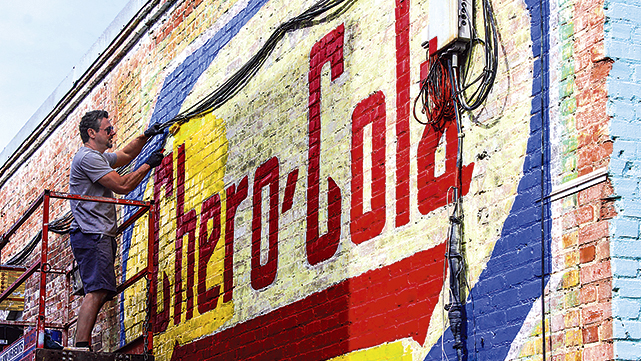The Bottle
The Bottle via
We went to Auburn, Alabama, this past Christmas to visit my mom’s side of the family. On the drive between the Atlanta airport and the small college town, I checked my phone to see how far along we were. A short distance north of Auburn I saw The Bottle, Alabama. Curious, I zoomed in. No real town, no buildings. I dropped a pin-- just an intersection of highways. Weird, I thought, and quickly forgot about it.
The Bottle today via
A couple days later I was looking into the history of the Auburn train depot and came across an old picture of a giant bottle. The Bottle.
In the 1920’s, the Union Bottling Co. operated out of nearby Columbus, Georgia, with Chero-Cola, a sweet, caramel-colored soda as its primary beverage. In 1924, Chero-Cola introduced Nehi Cola as its multi-flavored sodas, and the product took off. It became so popular that Chero-Cola eventually changed its name to the Nehi Corporation.
There are two origin stories for the Nehi name. The first is that when Chero-Cola founder Claude Hatcher sent a salesman to scope out the competition in Alabama, the salesman returned and said the competition was only “knee-high”. The other is that the early Nehi sample bottles were 2-3 ounces larger than competitor brands’, making the competitors look only “knee-high”.
In 1924, Margaret Bradley was eleven years old when a man knocked at her family’s door in Farmville, Alabama. He was known about town as “Chero-Cola” Williams because he owned the Nehi Bottling Company in neighboring Opelika, and he wanted to use the edge of the Bradleys’ land to build the world’s largest Nehi bottle as an advertisement for the new drink.
When The Bottle was completed later that year, it stood at 64 feet tall, 49 feet wide at the base, and 16 feet wide at the top. While made of wood, it was also covered in a sort of shiny material to give the illusion of glass. And it was painted bright orange. The base of The Bottle was home to a gas station and country store, and the second floor provided lodging for the caretaker of the store; there was no electricity in the structure. A winding staircase led to the bottle’s cap, which opened up to a view of Auburn and Opelika.
The Bottle became a gathering place for tourists and locals alike, and eventually the corner itself came to be known as The Bottle. The Bradleys built a barbeque cafe on the side of the gas station, with Margaret Bradley’s aunt moving into The Bottle and running the shop.
One morning in 1933, Margaret looked outside and saw The Bottle burning, and her aunt jumping out of it. Since there was no Farmville fire department, The Bottle burned to the ground. It’s believed that the fire started in the barbeque pit.
Though The Bottle only stood for nine years, the intersection of Highways 280 and 147 continued to be called The Bottle, and the name remains on maps today. In 2015, the site was given a historic marker (which falsely states that The Bottle burned in 1936).
The historical marker at The Bottle via
Sources
Nehi, Wikipedia
A Brief History of the Royal Crown Cola Company, Royal Crown Cola.
The Bottle, Alabama, Wikipedia.
Kelly Kazek, Forgotten Tales of Alabama, (The History Press: Charleston, 2010).
‘The Bottle’ in Auburn will receive historic marker, Opelika Auburn News
Locals to Remember the Bottle in Dedication, The Auburn Villager












